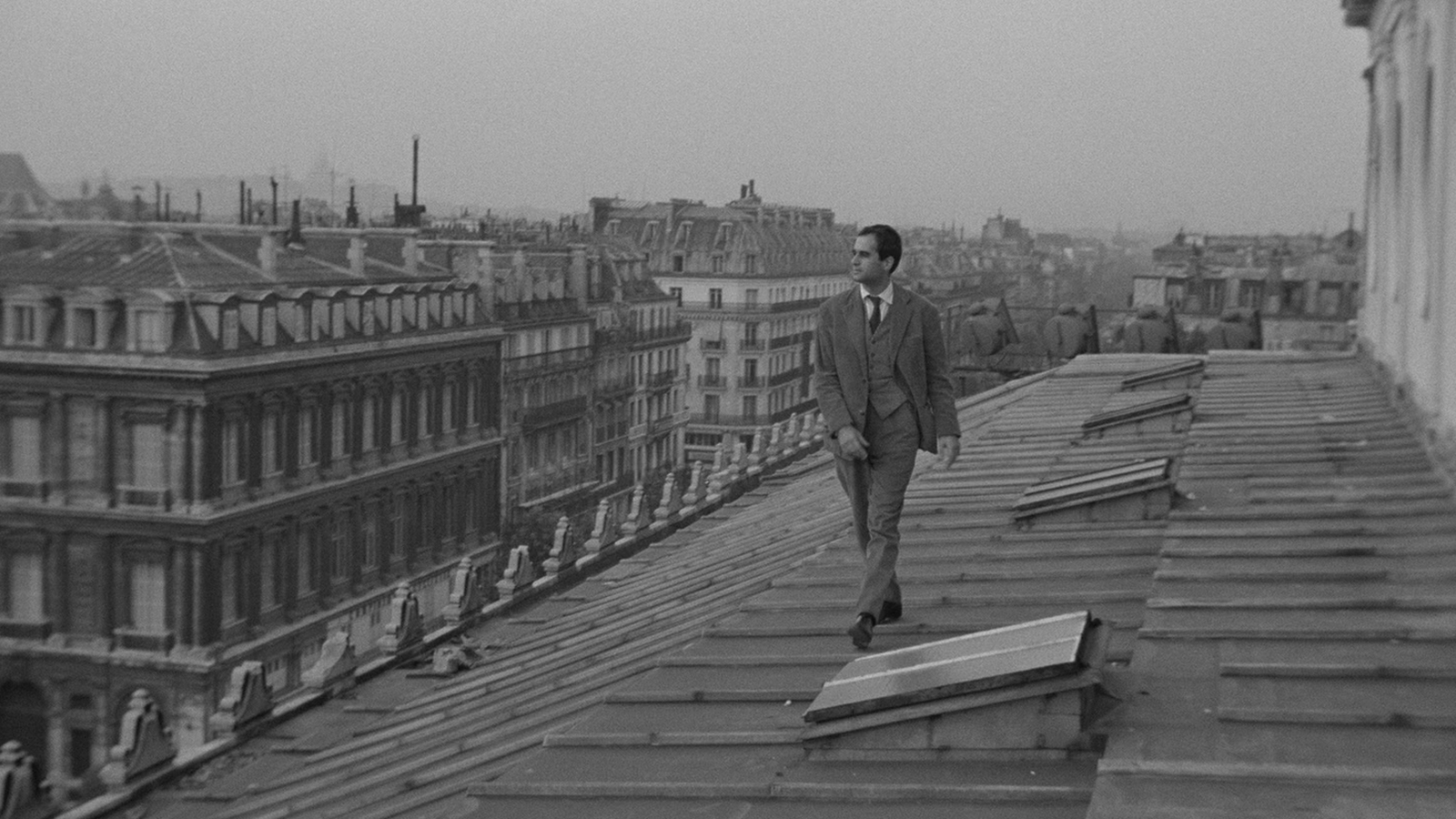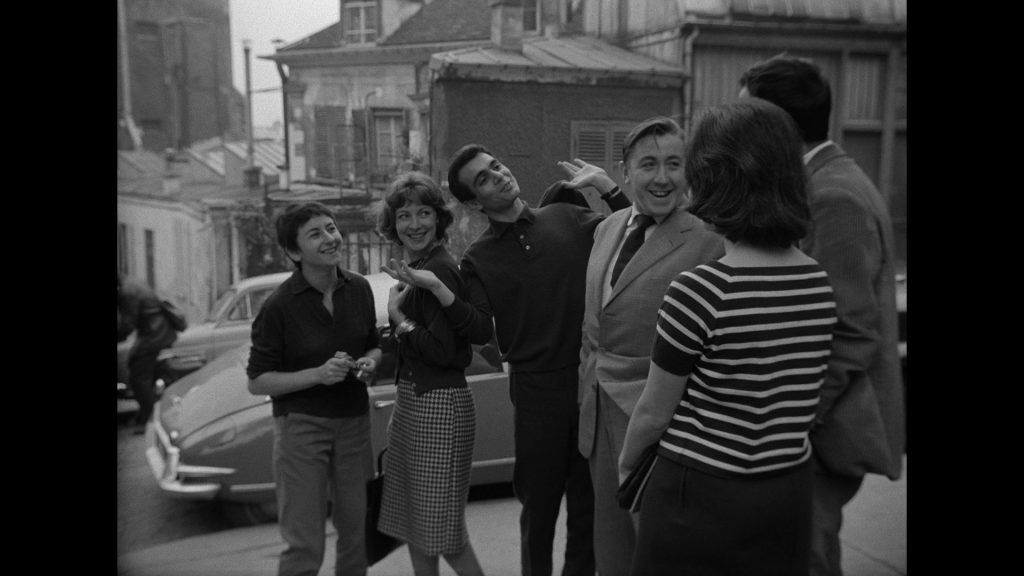
13 Eki PARIS BELONGS TO US: NOTHING TOOK PLACE BUT THE PLACE
by Luc Sante
Paris Belongs to Us, Jacques Rivette’s first feature, was written in 1957 and shot from July to November 1958. Had it been released in a timely fashion, it would have been one of the very first films of the French New Wave, appearing after Claude Chabrol’s Le beau Serge (1958) but around the same time as Chabrol’s Les cousins and François Truffaut’s The 400 Blows (both 1959), and might have helped determine the direction of that phenomenon. Instead, lack of funds delayed postproduction work for six months, and then two years elapsed in the search for a distributor. When it finally premiered, on December 13, 1961, the landscape of French cinema looked very different from the time of the film’s making, having been radically reconfigured by The 400 Blows as well as Truffaut’s subsequent Shoot the Piano Player and Jean-Luc Godard’s Breathless (both 1960). In that new context of jump cuts and vérité-style intrusions, the elaborately choreographed Paris Belongs to Us suddenly looked rather old-fashioned, and if it did not quite pass unnoticed, its reception was still somewhat muted.
Nevertheless, the film contains within its folds many of the radical elements that would distinguish the later career of Rivette, in particular the expansive and intransigent trio of pictures that mark his peak: L’amour fou (1969), Out 1 (1971), and Céline and Julie Go Boating (1974). These elements include a female point of view, a fascination with the rehearsal process of theater, a feeling for the geographic intricacies of Paris, and a sense of shadowy and unnameable conspiracy—though in Paris Belongs to Us, they may not appear very groundbreaking, woven as they are into a portmanteau that combines two venerable structures: a detective story and that of a young person’s coming-of-age. It would take another decade for Rivette to fully match his style and his content, and to develop the collaborative methods that would lead this early proponent of the auteur theory to undermine from within the very idea of the auteur, so that Bernadette Lafont could say, in the cultural context of the 1970s: “He is a kind of Mao, and his films are a Cultural Revolution.”
Rivette, born in Rouen in 1928, into a family of pharmacists, arrived in Paris in 1949 with a twenty-minute silent film, Aux quatre coins, already under his belt. He gravitated to the Cinémathèque française on avenue de Messine, where he soon met Godard, Truffaut, Chabrol, and Éric Rohmer. Along with them, he began writing for Cahiers du cinéma in 1951, becoming one of that magazine’s most incisive and learned critics. Rivette was a cineaste’s cineaste. An author writing in 1976 noted that of all the original Cahiers critics, he was by then the only one who could still be seen regularly at Cinémathèque screenings. But despite his profound immersion in movies, he was also responsible for enlarging the scope of the magazine, whose editor in chief he was from 1963 to 1965, for example by running interviews with such noncinematic figures as Roland Barthes, Pierre Boulez, and Claude Lévi-Strauss. He possessed a deep literary culture, although he has tended to employ literature in nonliterary ways, using Balzac, Henry James, Lewis Carroll, and others in much the same way that Godard employed American crime novels: only their scaffolding remains visible. (It is important to note here his longtime collaboration with the exceedingly literate Suzanne Schiffman, dialogue coach on Paris Belongs to Us, codirector and cowriter on Out 1, cowriter on five other Rivette movies, and assistant director on three more. She collaborated in similar ways with Truffaut and remains the unacknowledged force behind the New Wave.) Rivette was the first of the Cahiers critics to make a film but the last to achieve a personal style. After Aux quatre coins, he shot two more “apprentice” shorts in the early 1950s and then, in 1956, the rather formal twenty-eight-minute Le coup du berger, a study of coupling and uncoupling among four people that was inspired by chess moves, a divorce trial then in the news, and perhaps a lingering memory of Choderlos de Laclos’s eighteenth-century novel Les liaisons dangereuses.

Paris Belongs to Us is altogether looser, more subjective, and more complex. It follows Anne Goupil (Betty Schneider), twentyish and recently arrived in the capital, as she gets herself involved with a large and troubled cast of characters—artists, intellectuals, and expatriates. It begins when her brother, Pierre (François Maistre), somewhat older and very knowing, tells her about a party. When she arrives, all the guests are preoccupied with the recent suicide of Juan, a promising young Spanish composer and friend to all of them. Reproaches are directed at a couple of other Spanish exiles, for their bitterness and despair, reproaches that are led by Philip Kaufman (Daniel Crohem), an American journalist and winner of the Pulitzer Prize, who himself has been exiled to France as a victim of McCarthyist blacklisting. There is further murky business between him and another American expat, Terry Yordan (Françoise Prévost), who has arrived late, in the company of the theater director Gérard Lenz (Giani Esposito). Terry had been Juan’s lover, and Philip accuses her of being morally responsible for his suicide. As Anne leaves the party, she asks Pierre why Juan killed himself. “Because he was a jerk,” he replies.
The viewer, like Anne, is reeling by this point: the immediate hothouse drama, the accumulation of characters. The following day, Anne meets an old classmate from the provinces, Jean-Marc (Jean-Claude Brialy), who has come to Paris to pursue a career in the theater. He leads her to a barnlike room where Gérard is attempting to mount a bare-bones production of the enigmatic Pericles, perhaps Shakespeare’s least performed play (modern scholars believe he wrote only half of it). It is a sprawling drama, covering five cities and twenty years—an unlikely prospect for underfunded staging. In addition, the production is plagued by problems, beginning with the fact that the actors are constantly taking off to work or to audition for other plays, so that Gérard has never once been able to gather the entire cast at one time. In fact, when Anne shows up, an actress has just dropped out of the production, and Gérard hands her a script so she can fill in. He engages her on the spot as a member of the troupe, and the convolutions multiply. The search for a lost guitar score becomes a search for the truth about Juan’s suicide, and that in turn leads into the labyrinthine bowels of a shadowy conspiracy. Revealed through hints and suggestions, this conspiracy may be purely a product of some of the characters’ febrile imaginations, but on the other hand, it seems to be racking up an actual body count. Although Paris Belongs to Us, at about 140 minutes, is nowhere near the epic length of some of Rivette’s subsequent movies, it already shows his wish to plunge the viewer into an immersive 360-degree experience that is at least as novelistic as it is cinematic.
The first title to appear after the credits is a quote from the poet Charles Péguy: “Paris belongs to no one.” In a statement he issued to accompany the release of the film, Rivette wrote: “A film is, in general, a story built upon an idea; I tried to tell the story of an idea, with the aid of the detective story form; that is to say that, instead of unveiling primary intentions at the end of the story, the denouement can’t do anything but abolish them: ‘Nothing took place but the place.’ ” The movie does involve an awful lot of Paris, from Auteuil to Ménilmontant to the Latin Quarter; luxury flats, chambres de bonne, grimy residential hotels; assorted theaters, café terraces, streets of all sizes. Even if you are not familiar with the city, you can nevertheless get a sense of the encyclopedic accretion of high-and-low contrasts, a pileup that seems to illustrate the movie’s title even as it suggests the city’s ungovernable immensity. Similarly, the suggestions of conspiracy—of the ineffable linkage of every person, place, and thing—are both grounded in and challenged by the picture’s irrefutable, hard-core materiality. It is specific in its dating (1957), in the furnishings of rooms, the poses and stances, the reading materials left lying around, the posters on walls.
In the fraught scenes leading up to the ending, you can several times spot a poster for that year’s commemoration of the Paris Commune at Père-Lachaise Cemetery, a detail surely not idly chosen; and one particularly resonant exchange of climactic dialogue is silently accompanied by an issue of Cahiers du cinéma peering down from a shelf. An American in a café can be heard assessing Nixon’s presidential chances in English, and while this may be purely accidental, it fits right in with the casting of Daniel Crohem as the leftish American journalist—he bears an eerie resemblance to the young Sterling Hayden, who had briefly been a member of the Communist Party, but named names before the House Un-American Activities Committee. Note too that the character names Philip Kaufman and Terry Yordan together allude to Philip Yordan, a Hollywood screenwriter (Johnny Guitar, The Big Combo) who allowed the blacklisted Ben Maddow to use his name on several scripts. Of course, you can add all these things together, and throw in the Spanish exiles plotting to go home and organize strikes in order to undermine Franco, but you will not arrive at a decipherable code. What you get instead is the somber and confused mood of the late 1950s, when threats seemed abundant and paths of resistance few. The evocation of a political mood through the buildup of cultural litter—overheard talk, literary citations, bits of decor, paranoid mutterings—is exactly the same strategy Rivette was to employ when he made Out 1, which is preoccupied with people’s feelings of betrayal and letdown in the wake of May ’68.
Paris Belongs to Us might have been unbearably obsessive were it not for Betty Schneider’s performance as the forthright, determined, and clear-eyed Anne, who is an audience proxy in the classical tradition—sufficiently naive that she has to have things explained to her, but not so much that she takes things lying down. (Schneider is so good it’s a wonder she didn’t enjoy a longer career—she appeared in a total of nine films, which also include Jacques Tati’s Mon oncle and Claude Sautet’s Classe tous risques, all between 1957 and 1962.) The picture is remarkably sophisticated in its handling of space, from cramped apartments to cavernous rehearsal rooms to half-empty boulevards seen from the backs of taxis—but its use of cinematic visual rhetoric does seem to belong to a tradition that was already then falling away. Rivette was in fact to make only one other movie—La religieuse (1966)—that was fully scripted and storyboarded in advance. Afterward, he employed open-ended scripts, improvised sequences, characters developed in collaboration with the actors, and, at various times, methods of guerrilla filmmaking, such as the competing 16 mm and 35 mm crews in L’amour fou. Paris Belongs to Us might be seen as his thesis film, a brilliantly accomplished résumé of all that he has learned from his teachers (Rossellini, Mizoguchi, Hitchcock, Lang, among others), along with an understated announcement of the new directions in which he intends to set off in the future. However unlucky the circumstances of its release may have been, Paris Belongs to Us ultimately earned him his wings.
This article is taken from The Criterion Collection website.


